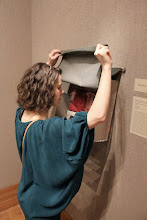Why do I like to watch Louis C.K.? I need to write it out
because every time I tell my friends I fumble on a worthwhile reason. It is
worth watching in the way that Lena Dunham’s “Tiny Furniture” is worth
watching. And Sheila Heti’s book “How a Person Should be” is worth reading.
Because it exposes the UGLY.
It is appropriate for a backlash of this sort to come about
with the overuse of photoshop to create visual human perfections. One recent subway
ride I stood behind a young boy as he learned how to use Photoshop to erase the
lines around an eye and pores on a cheek. The step-by-step process was a
step-by-step slide into my morning depression. Why spend time doing this?
Learning how to do this? Why is this a high demand job? Why is it even a job?
The exposure of our frailties hold a weak link that is a powerful opportunity to
connect to others. It shows that we need one another and are not perfectly
suited to go it alone.
Louis C.K. pronounces his ugly more than we want to hear.
But the force of it, the exaggeration of it is what makes it art. It separates
it from the day-to-day mini-doubts that are our realities and not so hilarious.
The glaring ugly that Louis exposes is what sticks in our minds as an abstract
notion of dirty human-what we all are. But...and of course there has to be a
but, because dirty human is not enough. Dirty human is pathetic and a hopeless
dead-end.
But Louis C.K. contrasts his UGLY with sublime. Little
moments of dripping love show through. These are not grand or glorified, they
catch you unaware, that is why they are sublime. And the moments are about love.
They are about love for life, love for strangers, when it is awkward and
socially clunky, love for ones’ children, messy and unconditional. Sexy,
slippery, yucky, mojo love, brotherly love, sisterly love, motherly love, scared
love, fearless love, love from behind and straight ahead, in the peripheral and
far away. This is why the UGLY is
acceptable, because there is, when you get to the real grit of being
human, so much LOVE.
